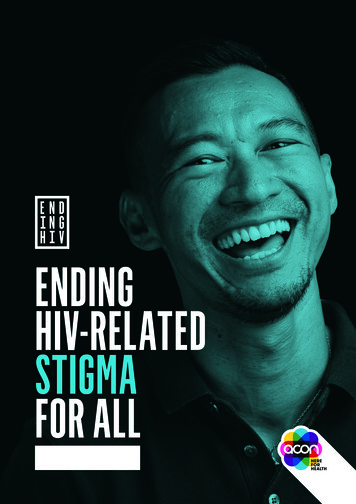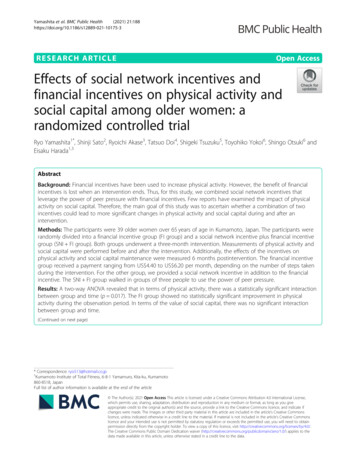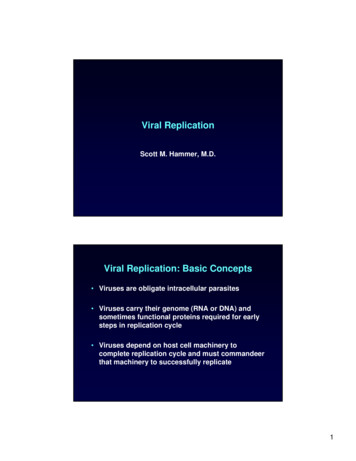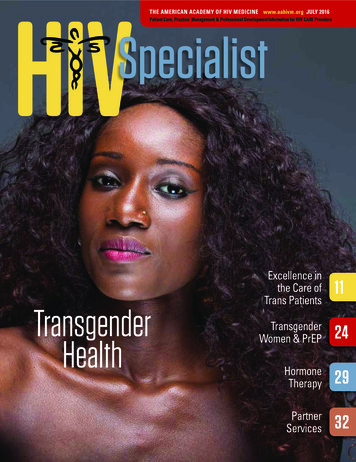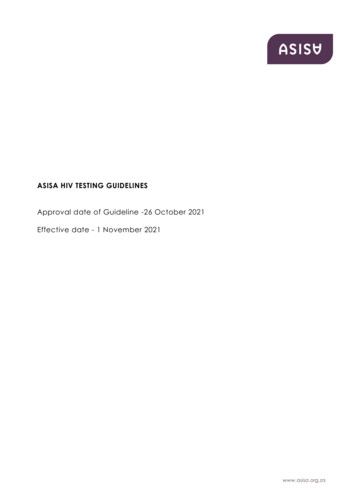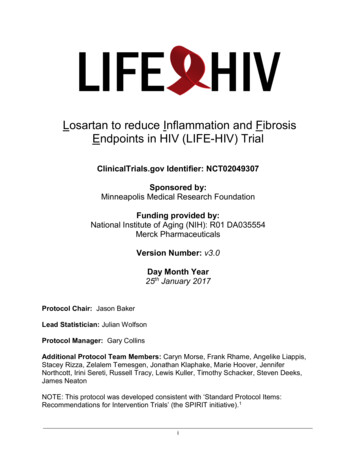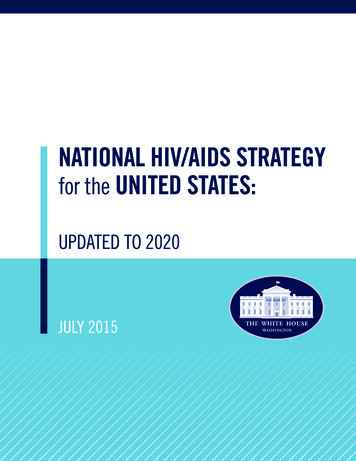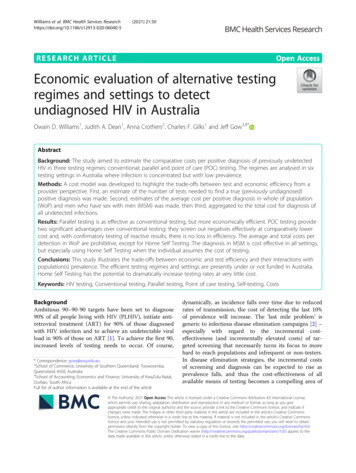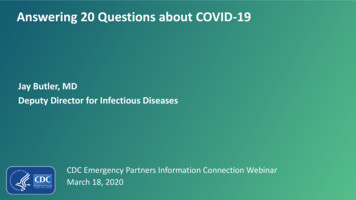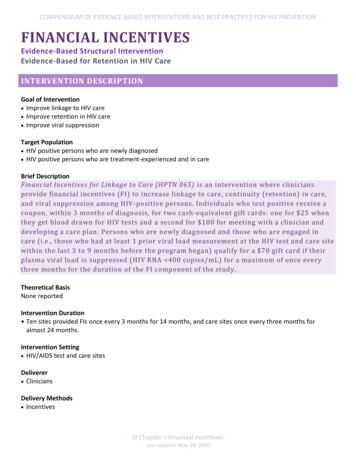
Transcription
COMPENDIUM OF EVIDENCE-BASED INTERVENTIONS AND BEST PRACTICES FOR HIV PREVENTIONFINANCIAL INCENTIVESEvidence-Based Structural InterventionEvidence-Based for Retention in HIV CareINTERVENTION DESCRIPTIONGoal of Intervention Improve linkage to HIV care Improve retention in HIV care Improve viral suppressionTarget Population HIV positive persons who are newly diagnosed HIV positive persons who are treatment-experienced and in careBrief DescriptionFinancial Incentives for Linkage to Care (HPTN 065) is an intervention where cliniciansprovide financial incentives (FI) to increase linkage to care, continuity (retention) in care,and viral suppression among HIV -positive persons. Individuals who test positive receive acoupon, within 3 months of diagnosis, for two cash-equivalent gift cards: one for 25 whenthey get blood drawn for HIV tests and a second for 100 for meeting with a clinician anddeveloping a care plan. Persons who are newly diagnosed and those who are engaged incare (i.e., those who had at least 1 prior viral load measurement at the HIV test and care sitewithin the last 3 to 9 months before the program began) qualify for a 70 gift card if theirplasma viral load is suppressed (HIV RNA 400 copies/mL) for a maximum of once everythree months for the duration of the FI component of the study.Theoretical BasisNone reportedIntervention Duration Ten sites provided FIs once every 3 months for 14 months, and care sites once every three months foralmost 24 months.Intervention Setting HIV/AIDS test and care sitesDeliverer CliniciansDelivery Methods IncentivesSI Chapter – Financial IncentivesLast updated May 29, 2020
COMPENDIUM OF EVIDENCE-BASED INTERVENTIONS AND BEST PRACTICES FOR HIV PREVENTIONStructural Component Social Determinants of Health – Survivalo Provided FIs in the form of cash equivalent gift cards 25 on getting blood drawn for HIV tests 100 for meeting with a clinician and developing a care plan 70 gift card if plasma viral load is suppressed (HIV RNA 400 copies/mL) for a maximum of onceevery three monthsINTERVENTION PACKAGE INFORMATIONAn intervention package is not available at this time. Please contact Wafaa El-Sadr, Schoolof Public Health, Columbia University, 722 W 168 th Street, PO Box 18, 13 th floor, New York,NY 10032.Email: wme1@cumc.columbia.edu for details on intervention materials.EVALUATION STUDY AND RESULTSStudy Location InformationThe original evaluation was conducted in in HIV test and care sites in Bronx, New York and Washington, D.C.from February 2011 through January 2013.Key Intervention Effects Increased continuity (retention) in HIV care Improved viral suppressionRecruitment SettingsHIV/AIDS test and care sitesEligibility CriteriaFor linkage to care, patients were eligible if they consented to HIV care according to New York State orWashington, D.C. law and were tested at a participating HIV test site and found to be HIV positive. Forcontinuity in care and viral suppression, patients were eligible if they consented to HIV care according to NewYork State or Washington, D.C. law and initiated care at participating HIV care sites.Study SampleBecause the study was a site-randomized, effectiveness trial, patients were not formally enrolled. For linkage to care, baseline was assessed among the linkage-to-care cases in the surveillance system duringApril 1, 2010 to March 31, 2011. Across the 34 testing sites, the baseline sample is characterized by thefollowing*:o Average number of HIV-positive cases per quarter (n 35)o 73% male; 27% femaleo 25% 13-24 years old; 28% 25-34 years old; 17% 35-44 years old; 22% 45-54 years old; 8% 55 years oldSI Chapter – Financial IncentivesLast updated May 29, 2020
COMPENDIUM OF EVIDENCE-BASED INTERVENTIONS AND BEST PRACTICES FOR HIV PREVENTION For continuity in care and viral suppression, baseline was assessed for HIV positive patients reported to be incare during January 1, 2010 to March 31, 2011. Across the 37 care sites, the baseline sample is characterizedby the following*:o Average number of HIV positive patients in care per quarter (n 374)o 64% male; 36% femaleo 10% 13-24 years old; 14% 25-34 years old; 26% 35-44 years old; 33% 45-54 years old; 17% 55 years oldAssignment MethodHIV testing and care sites were separately randomized to the FI intervention or standard of care (SOC)comparison. Thirty-seven testing sites (18 in the Bronx [9 sites allocated to F1 and 9 sites to SOC) and 19 (10sites allocated to F1 and 9 sites to SOC] in Washington, D.C.) participated in the linkage to care component.Thirty-nine HIV care sites (20 in the Bronx [10 sites allocated to F1 and 10 to SOC] and 19 [9 sites allocated toF1 and 10 sites to SOC] in Washington, D.C.) participated in the continuity of care and viral suppressioncomponent.ComparisonThe SOC group received no FIs.Relevant Outcomes Measured Linkage to care was defined as the proportion of individuals testing positive at each HIV test site who werelinked to care within 3 months as indicated by CD4 cell count or viral load test results in the surveillancesystem. Continuity (retention) in care was defined as the proportion of patients engaged in care (i.e., those who hadat least 1 prior viral load measurement at the HIV test and care site within the last 3 to 9 months) with CD4cell count or HIV viral load test results in the surveillance system during at least 4 of the prior 5 calendarquarters. Viral suppression was defined as proportion of patients engaged in care with the most recent viral load lessthan 400 copies/mL measured within 6 months.Participant RetentionBecause participant retention is not a criterion for the Structural Interventions chapter, the PreventionResearch Synthesis project does not evaluate that information.Significant Findings on Relevant Outcomes The proportion of patients with continuity in care was higher by 8.7% (95% CI, 4.2% - 13.2%, p 0.001) at FIsites compared to SOC sites.o In subgroup analyses, the proportion of patients with continuity in care was higher in FI sites comparedto SOC sites in: Bronx, NY (Increase in percent [IEP] 8.0, 95% CI: 4.1 -11.9; p 0.001) Washington, D.C. (IEP 10.1; 95% CI: 1.2 – 19; p 0.03) hospital-based sites (IEP 8.7; 95% CI: 3.4 – 14; p 0.001) community-based sites (IEP 9.4; 95% CI: 1.7 – 17.1; p 0.02) smaller sites with 196 patients at baseline (IEP 10.3; 95% CI: 1.5 – 19.2; p 0.02) larger sites with 196 patients at baseline (IEP 8.0; 95% CI: 2.4-13.6; p 0.005), and sites with higher viral suppression (baseline 66%) (IEP 8.7; 95% CI: 3.6 – 13.8; p 0.001). The proportion of patients achieving viral suppression was higher by 3.8% (95% CI, 0.7 – 6.8%, p 0.01) at FIsites compared to SOC sites.SI Chapter – Financial IncentivesLast updated May 29, 2020
COMPENDIUM OF EVIDENCE-BASED INTERVENTIONS AND BEST PRACTICES FOR HIV PREVENTIONIn subgroup analyses, the proportion of patients achieving viral suppression was higher in FI sitescompared to SOC sites in: Washington, D.C. (IEP 6.6%; 95% CI: 1.9% - 11.3%; p 0.006), hospital-based sites (IEP 4.9%; 95% CI: 1.4% - 8.5%; p 0.007), sites with lower viral suppression (baseline 66%) (IEP 5.6%; 95% CI: 0.0% - 11.3%; p 0.049), and sites with higher viral suppression (baseline 66%) (IEP 3.6%; 95% CI: 0.3% - 7.0%; p 0.03). The proportion of baseline inconsistent virally suppressed patients achieving viral suppression was higher by4.9% (95% CI, 1.4 – 8.5%, p 0.007) at FI sites compared to SOC sites.o In subgroup analyses, the proportion of baseline inconsistent virally suppressed patients achieving viralsuppression was higher in FI sites compared to SOC sites in: Washington, D.C. (IEP 8.7%; 95% CI: 3.9% - 13.4%; p 0.001), hospital-based sites (IEP 5.9%; 95% CI: 1.3% – 10.5%; p 0.01), larger sites 196 patients at baseline (IEP 4.1%; 95% CI: 1.1 – 7.0; p 0.008), and sites with higher viral suppression (baseline 66%) (IEP 4.6%; 95% CI: 0.8% - 8.4%; p 0.02).oConsiderationsNon-significant findings on relevant outcomes Financial incentives did not significantly increase linkage to care compared with SOC (adjusted odds ratio 1.10; 95% CI: 0.73 – 1.67; p 0.65).Other related findings This intervention is also determined to be evidence-based for the Linkage to, Retention in, andRe-engagement in Care (LRC) Chapter.Additional findings The FI intervention was evaluated for durability of the effects on viral suppression and continuity of careoutcomes after financial incentives ended (El-Sadr et al., 2019). Both outcomes were assessed during the 9months after the FI intervention withdrawal.o The proportion of patients with continuity in care was higher by 7.5% (95% CI: 2.0% - 12.9%, p 0.007)at FI sites compared to SOC sites. In subgroup analyses, the proportion of patients with continuity in care was higher in FI sitescompared to SOC sites in: Bronx, NY (Increase in Percent [IEP] 5.9%; 95% CI: 1.4% - 10.4%; p 0.01), hospital-based sites (IEP 8.0%; 95% CI: 1.3% - 14.6%; p 0.019), sites with higher viral suppression (baseline 66%) (IEP 7.9%; 95% CI: 1.6% - 14.2%); p 0.014).o The proportion of patients who achieved viral suppression was higher by 2.7% (95% CI: -0.3% - 5.6%) atFI sites compared to SOC sites, but this difference was not statistically significant (p 0.076). In subgroup analyses, the proportion of patients achieving viral suppression was higher in FI sitescompared to SOC sites in: hospital-based sites (IEP 4.8%; 95% CI: 1.6% - 7.9%; p 0.003) and smaller sites with 196 patients at baseline (IEP 11.5%; 95% CI: 1.9% - 21.1%); p 0.019).Implementation research-related findings None reportedSI Chapter – Financial IncentivesLast updated May 29, 2020
COMPENDIUM OF EVIDENCE-BASED INTERVENTIONS AND BEST PRACTICES FOR HIV PREVENTIONProcess/Study execution-related findings Prior to study initiation, the authors consulted with the study’s community advisory group to determine theappropriate value of the FI.Adverse events None reportedFundingThe HIV Prevention Trials Network (HPTN) 065 study is sponsored by the National Institute of Allergy andInfectious Diseases, the National Institute of Mental Health, and the National Institute on Drug Abuse, U.S.National Institutes of Health, under Cooperative Agreements #UM1 AI 068619 and UM1 AI 068617,as well as the National Center for HIV/AIDS, Viral Hepatitis, STD, and TB Prevention, Centers for DiseaseControl and Prevention.*Obtained from supplementary online content and correspondence with author.REFERENCES AND CONTACT INFORMATIONEl-Sadr, W. M., Donnell, D., Beauchamp, G., Hall, H. I., Torian, L. V., Zingman, B., . . . HPTN 065 Study Team.(2017). Financial incentives for linkage to care and viral suppression among HIV-positive patients: Arandomized clinical trial (HPTN 065). JAMA Internal Medicine, 177(8), 1083-1092.El-Sadr, W. M., Beauchamp, G., Hall, H. I., Torian, L. V., Zingman, B. S., Lum, G., . . . HPTN 065 Study Team.(2019). Durability of the effect of financial incentives on HIV viral load suppression and continuity in care:HPTN 065 study. JAIDS Journal of Acquired Immune Deficiency Syndromes, 81(3), 300-303.Researcher: Wafaa El-Sadr, MD, MPH, MPASchool of Public HealthColumbia University722 W 168th Street, PO Box 1813th floor, New York, NY 10032Email: wme1@cumc.columbia.eduSI Chapter – Financial IncentivesLast updated May 29, 2020
COMPENDIUM OF EVIDENCE-BASED INTERVENTIONS AND BEST PRACTICES FOR HIV PREVENTION SI Chapter - Financial Incentives Last updated May 29, 2020 FINANCIAL INCENTIVES . for two cash-equivalent gift cards: one for 25 when they get blood drawn for HIV tests and a second for 100 for meeting with a clinician and
